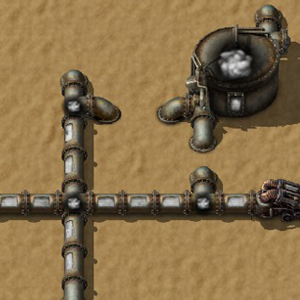Steam: Difference between revisions
m (fixed links) |
(Fix 'coal liquefaction' link) |
||
| Line 1: | Line 1: | ||
{{Languages}} | {{Languages}} | ||
{{:Infobox:Steam}} | {{:Infobox:Steam}} | ||
'''Steam''' is a [[fluid system|gas]] created by heating water in a [[Boiler]] or [[Heat exchanger]]. After being distributed via [[pipe]]s, steam can be used to generate electricity via [[Steam engine]]s and [[Steam turbine|Turbine]]s. Steam is also used in [[ | '''Steam''' is a [[fluid system|gas]] created by heating water in a [[Boiler]] or [[Heat exchanger]]. After being distributed via [[pipe]]s, steam can be used to generate electricity via [[Steam engine]]s and [[Steam turbine|Turbine]]s. Steam is also used in [[coal liquefaction]] in [[Oil refinery|Oil refineries]]. Since steam is a fluid, it can be stored in a [[storage tank]]. | ||
== Power generation == | == Power generation == | ||
Revision as of 19:53, 22 July 2018
| Steam |
|
Prototype type |
|
|
Internal name |
steam |
|
Required technologies |
|
|
None required |
|
|
Produced by |
|
|
Consumed by |
|
Steam is a gas created by heating water in a Boiler or Heat exchanger. After being distributed via pipes, steam can be used to generate electricity via Steam engines and Turbines. Steam is also used in coal liquefaction in Oil refineries. Since steam is a fluid, it can be stored in a storage tank.
Power generation
The amount of energy contained in steam is linearly proportional to it's temperature (minus 15°C ambient temperature). The energy storage of steam is exactly 200 Joule / unit / Celcius, so for every degree Celcius increase in temperature of a single unit of fluid requires exactly 200 Joules.
In all cases, steam produced in boilers is 165°C and steam from heat exchangers is 500°C. This higher temperature equates to a higher energy density of the same number of units of steam, meaning: higher temperature, more energy per volume. Steam suffers no thermal losses sitting or flowing through pipes or storage tanks, the energy put into water to create steam is the same amount of energy you get back out from it since both steam engines and turbines are 100% efficient. (Note: a boiler is only 50% efficient at generating steam!)
For example, a Storage tank which holds 25000 units of Steam at 165°C contains...
(200 Joule / unit / Celcius) * 25000 units * (165°C-15°C) = 750 000 000 joules = 750 MJ
A Storage tank holding 25000 units of Steam at 500°C thus contains 2.425 gigajoules of energy, a surprisingly large amount equal to 485 fully charged Accumulators!
(200 Joule / unit / Celcius) * 25000 units * (500°C-15°C) = 2 425 000 000 joules = 2.425 GJ
It's obvious a steam engine or turbine taking in steam that's colder than it's maximum temperature will not be able to produce full power. When this happens, power generation is limited by the maximum fluid consumption rate of the machine.
When a steam engine is fed steam hotter than it's maximum temperature, the power generation is limited to the maximum (900 kW) output of the machine and merely consumes less steam for the same energy output. This does not mean higher generation efficiencies are attained. Steam engines are perfectly usable on a 500°C nuclear power plant, they merely use more space than a turbines for the same amount power. Vice-versa, turbines are usable in 165°C boiler circuits as well.
Trivia
- The fill meter on steam storage tanks fills from the top instead of from the bottom
History
- 0.15.10:
- Introduced as separate fluid. Previously it counted as Water, with a >100 temperature.
